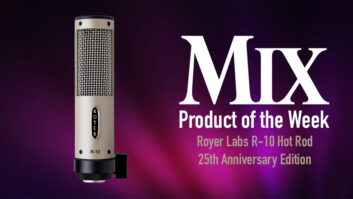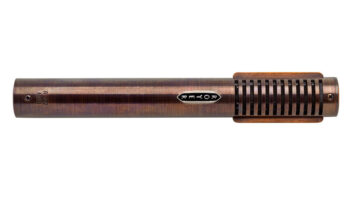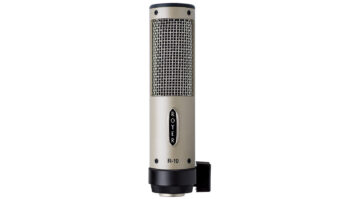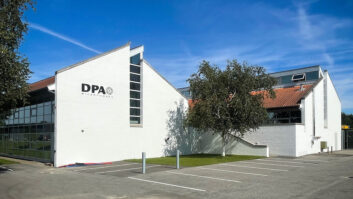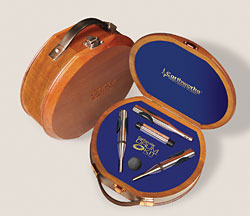
Getting a great drum sound is an art that lies somewhere between science and black magic, with myriad variables complicating the process. Techniques vary from one-mic-per-drum to a single-mic overhead for the entire kit, depending on the desired sound. Earthworks takes on the challenge with its DrumKit™ System, a three-mic solution offered in two flavors for stage and studio use.
Intended for recording, the DK25/R package reviewed here includes two Earthworks TC25 omnis for overheads, an SR25 cardioid condenser for kick drum, a KickPad™ and windscreen. The DK25/L bundle is designed for stage use and includes three SR25s (two for overheads, one for kick), a KickPad and windscreen. Both versions list for $2,100. The KickPad is also available separately for $120.
RIPPING INTO THE BOX
The SR25 has a 50 to 25k Hz (±2dB) response. The TC25 is an omnidirectional condenser with a 9 to 25k Hz (+1/-3 dB) response. Both mics require 48V phantom power and can handle a max SPL of 145 dB.
Rather than design a mic specifically for kick drum, Earthworks created the KickPad as an external passive processor to optimize the sound of the SR25 (or any mic) when used on kick. The KickPad is housed in a cylindrical tube roughly the diameter of an XLR connector and connects in-line between the SR25 and a mic pre. The SR25 can also be used on guitar, bass and other instruments.
Earthworks provides a guide with the DrumKit that illustrates placement of the overhead and kick mics. Similar to other condensers, the SR25 is sensitive to large bursts of air, so I used the windscreen and placed the mic as per recommendations in the manual, initially leaving the KickPad out. I found optimum placement pretty close to the suggestion on the manual, akin to the manner in which you would mike a floor tom: mic inside the rim pointed toward the head at an angle of about 45 degrees.
IN THE FIELD
Without the KickPad, the SR25 sounded bland, lacking the top-end snap and fat bottom typical of contemporary recordings. Placing the KickPad in-line extends the low frequencies, adds the requisite “smack” and applies a cut to the lower-mids. (It also reduces level by roughly -10 dB.)
As with many condenser mics, the SR25’s output is high as compared to that of a dynamic mic, so care must be taken not to overload the mic preamp. I found that some of my preamps could not handle the SR25’s output, even with the preamp’s pad on and gain turned all the way down.
As an experiment, I tried placing the SR25 directly in front of the hole in the kick drum’s front head. The mic handled the SPLs without a problem, but I preferred the smoother HF response of the off-axis placement. Fans of the Metallica kick drum sound are not going to get it here without adding considerable EQ. The SR25 proved more useful on recordings in which accuracy was more important than hype, especially with jazz and acoustic sessions.
I tried the KickPad with other mics, including the Audix D6, Sennheiser MD421 and Shure SM57. Generally, adding the KickPad was an improvement, although the difference was negligible with the Audix D6, a mic with a response tailored specifically for kick drum. With the SM57, the KickPad turned an ugly duckling into a nice kick mic, adding roundness and attack while removing the 57’s papery quality. As with the SM57, adding the KickPad to the MD421 gave the impression that the drum was moving more air.
The manual offers a variety of possibilities for placing the overheads; however, the manual shows an X/Y placement, but doesn’t mention that this technique works better with the (cardioid) SR25 overheads supplied with the DK25/L. There’s certainly no harm in positioning the studio package’s TC25 omni pair in X/Y stereo, but I had far better results with the TC25s as a spaced pair and in another configuration recommended in the manual. The latter suggests pointing the mics straight down, one between the snare and hi-hat and the other between the floor tom and kick drum, both five feet high. This placement yielded extremely realistic reproduction with an incredible sense of being in the room with the drums and great LF extension on the floor tom.
Components of the kit were perfectly balanced, and the TC25’s omnidirectional pattern evenly covered the kit without hot spots. As the mics were directly above the drums, room ambience was controlled, giving the snare and toms presence without isolating them from the kit. Placing the TC25’s in spaced pair — five feet high, two feet in front of the kit — gave a similar sense of space and realism with somewhat diminished L/R separation and a higher percentage of room ambience. Either placement delivered outstanding detail (you could easily hear a rattling wing nut) and quick response to transients, especially noticeable on snare drum.
THE RESULTS ARE CLEAR
Detail and realism is where the Earthworks DrumKit excels. The set will undoubtedly appeal to engineers more interested in capturing the sound of drums as opposed to artificially creating that sound. The microphones’ excellent transient response and ability to capture low-level detail make them a natural for acoustically oriented music, while fans of the John Bonham drum sound will find them equally useful.
Earthworks, 603/654.6427, www.earthworksaudio.com.
In addition to contributing to Mix, Steve La Cerra is the tour manager and front-of-house engineer for Blue Öyster Cult.


